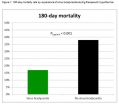(Press-News.org) An international research collaboration led by UC San Francisco researchers has identified a genetic variant common in Latina women that protects against breast cancer.
The variant, a difference in just one of the three billion "letters" in the human genome known as a single-nucleotide polymorphism (SNP), originates from indigenous Americans and confers significant protection from breast cancer, particularly the more aggressive estrogen receptor–negative forms of the disease, which generally have a worse prognosis.
"The effect is quite significant," said Elad Ziv, MD, professor of medicine and senior author of the study. "If you have one copy of this variant, which is the case for approximately 20% (the range being 10 to 25 percent) of U.S. Latinas, you are about 40 percent less likely to have breast cancer. If you have two copies, which occurs in approximately 1% of the US Latina population, the reduction in risk is on the order of 80 percent."
Published in the October 20, 2014 issue of Nature Communications, the new study showed that women who carry the variant have breast tissue that appears less dense on mammograms. High "mammographic density" is a known risk factor for breast cancer.
"We have detected something that is definitely relevant to the health of Latinas, who represent a large percentage of the population in California, and of other states such as Texas," said first author Laura Fejerman, PhD, assistant professor of medicine and a member of UCSF's Institute of Human Genetics. "This work was done as a collaboration of multiple investigators, many of us originally from Latin America. As a Latina myself, I am gratified that there are representatives of that population directly involved in research that concerns them."
Epidemiological data have long demonstrated that Latina women are less susceptible to breast cancer than women of other ethnicities. According to National Cancer Institute data from 2007 to 2009, whites have about a 13 percent lifetime risk of breast cancer, blacks about 11 percent, and Hispanics less than 10 percent. The lifetime risk among Hispanics with indigenous American ancestry is even lower.
For several years Fejerman and Ziv have studied Latina populations in search of genetic and biological explanations for these differences. "After our earliest studies we thought there might be a genetic variant that led to increased risk in European populations," said Ziv. "But what this latest work shows is that instead there is a protective variant in Native American and Latina populations."
In the new study, Fejerman, Ziv, and colleagues performed successive genome-wide association analyses of datasets from the Cancer Prevention Institute of California (CPIC) and a study known as the Multiethnic Cohort. They replicated their initial findings in data from the Women's Health Initiative study, from a study of breast cancer in Colombian women known as COLUMBUS, and from a study conducted in Mexico, ultimately incorporating DNA data from a total of 3,140 women with breast cancer and 8,184 healthy controls.
"Our breast cancer registry has recruited and followed more than 4,000 breast cancer families. For this study, we provided cases and controls who self-identified as Latina or Hispanic," said CPIC Senior Scientist Esther M. John, PhD, MSPH. "The DNA samples and data shared from these cases, combined with other samples from the San Francisco Bay Area, contributed to a total of 977 breast cancer cases and 722 controls that led to this important genetic discovery."
The newly discovered SNP is on Chromosome 6, near a gene coding for an estrogen receptor known as ESR1. Fejerman and Ziv said that the biological basis of the association between the variant and reduced breast cancer risk is still not known, but their preliminary experiments indicate that the variant interferes with the action of transcription factors, proteins that regulate the expression of the ESR1 estrogen receptor.
"If we can use these results to better understand how this protects estrogen receptor-negative breast cancer, that would be interesting and important," Ziv said, "because because right now we have no good way to prevent that type of breast cancer."
Fejerman and Ziv are working to identify additional risk variants in Latinas and to combine these variants into predictive risk models for US Latinas. They are also collaborating with UCSF colleagues Laura J. Esserman, MD, MBA, professor of medicine, and Laura J. van 't Veer, PhD, professor of medicine, on large-scale initiatives, still in the design state, to introduce testing for variants such as the newly identified SNP as part of breast cancer screening.
INFORMATION:
The study was funded by grants from the National Cancer Institute.
UCSF is the nation's leading university exclusively focused on health. Now celebrating the 150th anniversary of its founding as a medical college, UCSF is dedicated to transforming health worldwide through advanced biomedical research, graduate-level education in the life sciences and health professions, and excellence in patient care. It includes top-ranked graduate schools of dentistry, medicine, nursing and pharmacy; a graduate division with world-renowned programs in the biological sciences; a preeminent biomedical research enterprise; and top-tier hospitals, UCSF Medical Center and UCSF Benioff Children's Hospitals. Please visit http://www.ucsf.edu.
Blind cave fish may not be the first thing that comes to mind when it comes to understanding human sight, but recent research indicates they may have quite a bit to teach us about the causes of many human ailments, including those that result in loss of sight. A team of researchers, led by Suzanne McGaugh, an assistant professor in the University of Minnesota's College of Biological Sciences, is looking to the tiny eyeless fish for clues about the underpinnings of degenerative eye disease and more. A new study, published in the October 20 online edition of Nature Communications, ...
Head Start programs may help low-income parents improve their educational status, according to a new study by Northwestern University researchers.
The study is one of the first to examine whether a child's participation in the federal program benefits mothers and fathers – in particular parents' educational attainment and employment.
"Studies on early childhood education programs have historically focused on child outcomes," said study lead author Terri Sabol, an Assistant Professor of Human Development and Social policy at Northwestern's School of Education ...
Geneva, Switzerland – 20 October 2014: Researchers may have developed a way to potentially assist prognostication in the first 24 hours after out-of-hospital cardiac arrest (OHCA) when patients are still in a coma. Their findings are revealed today at Acute Cardiovascular Care 2014 by Dr Jakob Hartvig Thomsen from Copenhagen, Denmark.
Acute Cardiovascular Care is the annual meeting of the Acute Cardiovascular Care Association (ACCA) of the European Society of Cardiology (ESC) and takes place 18-20 October in Geneva, Switzerland.
Dr Thomsen said: "When we talk ...
According to Nationwide Children's Hospital researchers, 63,000 children under the age of six experienced out-of-hospital medication errors annually between 2002 and 2012. One child is affected every eight minutes, usually by a well-meaning parent or caregiver unintentionally committing a medication error.
The most common medication mistakes in children under the age of six occur in the children's home, or another residence and school. The most common medicines involved are painkillers and fever-reducers like ibuprofen and acetaminophen.
"This is more common than people ...
Ankylosing spondylitis is a systemic disease that causes inflammation in the spinal joints and was thought to have affected members of the ancient Egyptian royal families. Now a new study published in Arthritis & Rheumatology, a journal of the American College of Rheumatology (ACR), refutes that claim, finding instead a degenerative spinal condition called diffuse idiopathic skeletal hyperostosis (DISH) in royal Egyptian mummies from the 18th to early 20th Dynasties.
Ankylosing spondylitis is a member of a group of inflammatory conditions called the spondyloarthropathies ...
CHICAGO, OCTOBER 20, 2014 – The U.S. Government has initiated a major effort to prevent and effectively treat Alzheimer's disease by 2025. However, a workgroup of nearly 40 Alzheimer's researchers and scientists says the research milestones in the U.S. Government's National Plan to Address Alzheimer's Disease must be broadened in scope, increased in scale, and adequately funded in order to successfully achieve this goal. A series of proposals by the workgroup to enlarge and strengthen the Plan are published today in Alzheimer's & Dementia: the Journal of the Alzheimer's ...
Scientists have uncovered a surprising way to reduce the brain damage caused by head injuries - stopping the body's immune system from killing brain cells. The study, published in the open access journal Acta Neuropathologica Communications, showed that in experiments on mice, an immune-based treatment reduced the size of brain lesions. The authors suggest that if the findings apply to humans, this could help prevent brain damage from accidents, and protect players of contact sports like American football, rugby and boxing.
To date, there are no effective treatments to ...
Viagra could be used as a safe treatment for heart disease, finds new research published today in the open access journal BMC Medicine. The study reveals that long-term daily treatment of Viagra can provide protection for the heart at different stages of heart disease, with few side effects.
Phosphodiesterase-5 inhibitor (PDE5i) is the main ingredient in Viagra and other drugs commonly used to treat erectile dysfunction. The inhibitor blocks the enzyme PDE5, which prevents relaxation of smooth muscle tissue. The presence of PDE5 in the heart has led to previous research ...
The findings suggest that this disturbing trend could be due the emergence of more virulent group B streptococcal strains and call for a renewed evaluation of preventive strategies to reduce neonatal disease.
Passed from mother to child during birth, group B streptococcus is the most common cause of infection in newborns. Guidelines for the prevention of disease have been widely adopted in high-income countries. But despite these efforts, the bacterium remains a leading cause of blood stream infections and meningitis worldwide, typically affecting babies younger than ...
BETHESDA, MD – Breaking down complex conditions such as Type 2 Diabetes and obesity into the specific metabolic proteins and processes that underlie them offers a new approach to studying the genetics of these diseases and how they are interrelated, according to research presented today at the American Society of Human Genetics (ASHG) 2014 Annual Meeting in San Diego.
By studying specific proteins that contribute to such conditions – and the genes that encode them – scientists can develop new drugs that directly target the metabolic processes that do ...


